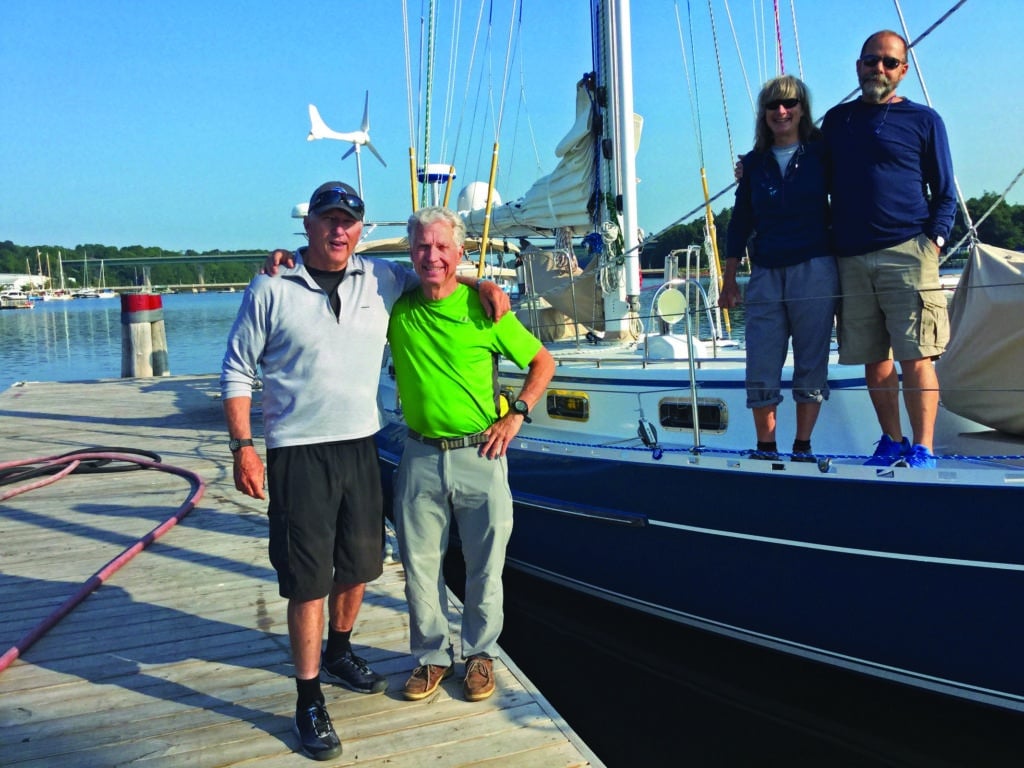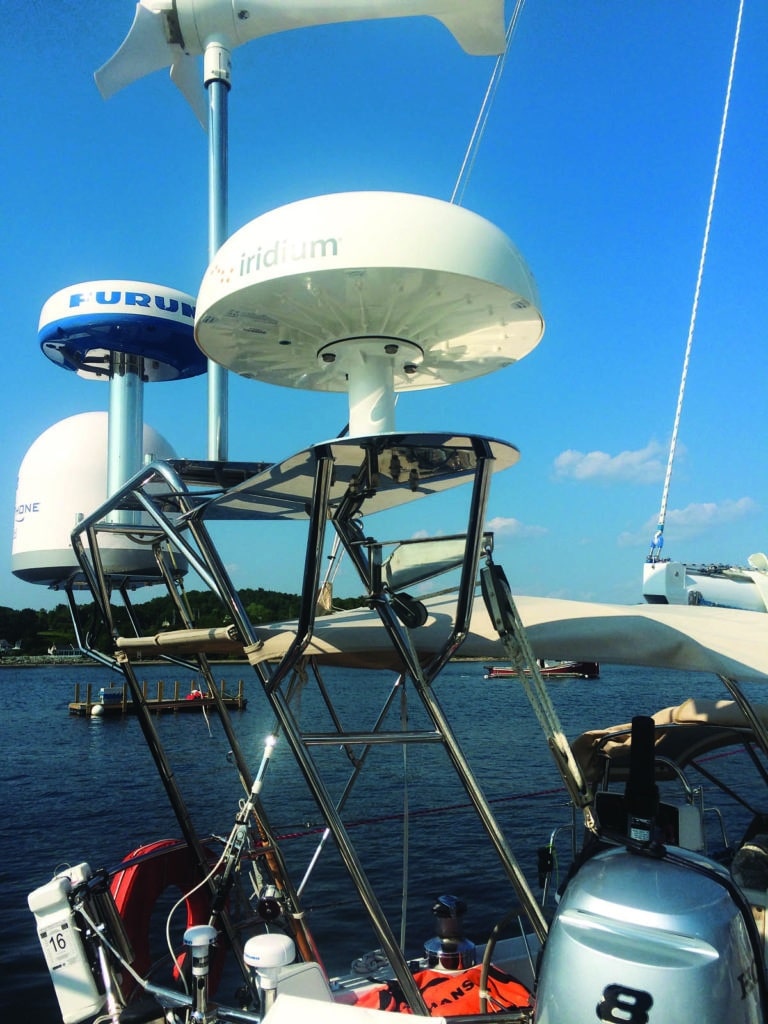Part 2: Saturday, July 12
The good news was that the extended forecast for the first four days of the trip, provided by Commanders’ Weather, was ideal. A steady southwesterly flow would sweep us out of the Gulf of Maine and into the Atlantic on a sweet reach, with nothing tropical on the horizon to worry about.
Our first 24-hour run of 135 miles had been respectable, especially considering we’d motored from Belfast all the way out of Penobscot Bay. Once into the open gulf, the sou’wester filled in at about 12 knots, and with a full main and genoa on flat water, we trucked right along, averaging a solid 8 knots. It was lovely sailing; Eleanor was a thoroughbred, seakindly and resolute. We battled some strong current overnight as big tides coursed northerly into the Bay of Fundy. Accordingly the seas built, slowing our progress, though we cracked off a bit for some extra grunt. The night was clear but also cold; everyone on watch was layered up in fleece and down.
Dawn brought a visual treat, with the classic ketch Whitehawk crossing close by our bow. By midafternoon we were 65 miles south of Cape Sable, Nova Scotia. The breeze built as the day progressed (as did the heat and humidity), poking into the low 20s a couple of hours later. Hasse and I made the first sail changes, tucking in a mainsail reef and replacing the genoa with the staysail. The barometer, locked in at 1027 millibars, hadn’t budged since we’d left, supporting the initial forecast of steady high pressure.
In the short term, things were commencing more or less as planned, though Logan seemed to be doing a lot more tinkering with various glitches than sailing.
The bigger question, though we didn’t need to answer it immediately, was less clear and more confounding: Which course, exactly, would we follow to Scotland?
The popular option was to stop first at the Azores before heading north to the British Isles. But the more direct Great Circle route would shave several hundred miles and a week or more from the voyage.
We each had our preferences. Mine was to skip the Azores and beeline it to Scotland. But even that idea wasn’t exactly straightforward. The previous winter, calving glaciers from the Greenland fjords had become a veritable iceberg factory. A cold and stormy spring had dispersed the bergs far and wide, with some reportedly spotted as far south as latitude 42. So the classic Great Circle route wasn’t even an option. Coincidentally, at the same time we were underway, there was an ongoing Transatlantic Race, sponsored by the New York Yacht Club, from Newport to England. Because of the southern ice hazards, the race committee had instituted an “ice-exclusion zone” that the racers were obliged to leave to port before altering course northward to the finish line.
Following the race reports had been instructive regarding the ice, though I realized crews on many of the boats had got their butts seriously kicked by extreme conditions, and this would likely be our fate too. Overall, it was turning into an eventful, nasty North Atlantic summer. But if we wanted to make our deadlines, this struck me as the best choice: head due east for several hundred miles, as the racing fleet had, more or less straddling the 42nd parallel, then hang a left for Scotland on a modified Great Circle route — weather permitting, of course.
As the only one on board who’d actually crossed the North Atlantic, and on a classic Great Circle, I had some experience in the high latitudes. Sure, it’d been three decades earlier, when I was in my late 20s and full of piss and vinegar. I’d signed on with legendary British sailor Robin Knox-Johnston to attempt an east-to-west transatlantic record on his 60-foot cat, British Airways. Shortly into it, we got our asses handed to us on the Grand Banks — in the same spot and the same sort of weather that Sebastian Junger later mined for a little story he called The Perfect Storm. By any standard, that part had been miserable (yet exciting!), but once the weather stabilized, the ongoing leg to England was fast and magical — the best trip I’d ever had. It had been real, flat-out, no-compromise sailing. All these years later, I still wanted more.
By the way, I pointed out to my crewmates, Oban, Scotland, lies at 56 N. Sooner or later, if you want to go to Oban, you’ve got to point the bow north.
Hasse thought I was nuts, though she was too polite to say it. She’d been counseled by her friends John and Amanda Neal, who run the sail-training concern Mahina Expeditions. She was all for the southern option via the Azores that they’d recommended. Billy had been given the same advice by his vastly experienced Islesboro friend Earl MacKenzie, who had crossed the Atlantic several years earlier on his schooner, Bonnie Lynn. “Too stormy” was Earl’s assessment of the northern route.
That said, because of the tight time frame, Billy was open to skipping the Azores. Logan remained uncommitted, though he might have just been humoring me. In any case, that fork in our road still lay more than a week away. As things turned out, it was a choice we never had to make.
Herb McCormick is CW’s executive editor and the author of As Long As It’s Fun, the award-winning biography of Lin and Larry Pardey.










